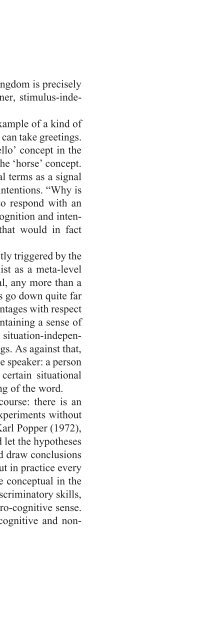Cognitive Semantics : Meaning and Cognition
Cognitive Semantics : Meaning and Cognition
Cognitive Semantics : Meaning and Cognition
You also want an ePaper? Increase the reach of your titles
YUMPU automatically turns print PDFs into web optimized ePapers that Google loves.
94 ÅKE VIBERG<br />
Intentional level. In its prototypical use, slå is a goal-directed action represented<br />
by the predicate ACT, which generally appears in most verbal semantic<br />
fields. In less prototypical uses, the intentional meaning is missing, as in Per<br />
slog huvudet i taket ‘Per hit his head against the ceiling’.<br />
Similar to many basic motion verbs, slå also involves a characteristic Body<br />
movement with a characteristic ‘shape’. In certain uses, this part of the meaning<br />
is focused as in Per slog ut med armarna ‘Per spread his arms’. Characteristic<br />
motion patterns of the limbs constitute important organizing principles for<br />
motion verbs. Subject-centered motion verbs like walk, run, jump, in particular,<br />
refer to motions of the legs <strong>and</strong> feet, while many of the most basic objectcentered<br />
motion verbs such as put, throw, pull <strong>and</strong> push refer to characteristic<br />
motion patterns of the arm <strong>and</strong> h<strong>and</strong>. (See the analysis of Swedish dra ‘pull’,<br />
‘draw’ in Viberg, 1996b). The characteristic motion pattern of the arm is<br />
indicated loosely as STRETCH(ARM) in Table 3, which needs further specification.<br />
The planning <strong>and</strong> control of every-day motion patterns such as lifting<br />
a cup to one’s mouth are extremely complex (Hollerbach 1990a,b). The most<br />
important aspect of the body motion from the point of view of slå as a physical<br />
contact verb, the concomitant motion of the h<strong>and</strong>, is indicated as TRAVEL(x).<br />
Motion is so central to the verbs of physical contact that most of them<br />
could be regarded as specialized types of motion verbs. Actually, the most<br />
general motion verb in Swedish, röra ‘move’, might be regarded as superordinate<br />
to many of the verbs of physical contact. This applies in particular to the<br />
subfield called Light contact in Table 2. Verbs of motion can be divided into<br />
subject-centered verbs of motion such as walk <strong>and</strong> run, which describe the<br />
displacement of the subject, <strong>and</strong> object-centered verbs of motion, such as<br />
throw <strong>and</strong> put, which describe the displacement of the object. Basically röra is<br />
an object-centered motion verb (often with a directional spatial particle such<br />
as ut ‘out’):<br />
Han rörde ut pannkakspulvret med He stirred some water into the<br />
kakao i vatten. pancake mix <strong>and</strong> cocoa.<br />
But in the reflexive form it is a subject-centered motion verb corresponding to<br />
intransitive ‘move’:<br />
Klockan hade en visare som rörde The clock had a h<strong>and</strong> which moved<br />
sig mycket långsamt, very slowly,<br />
In its uses as a verb of Physical contact, it usually refers to light contact (often<br />
in combination with the preposition vid ‘at, near’):















